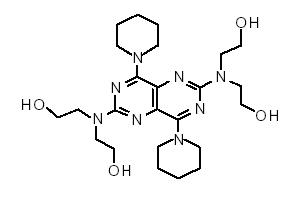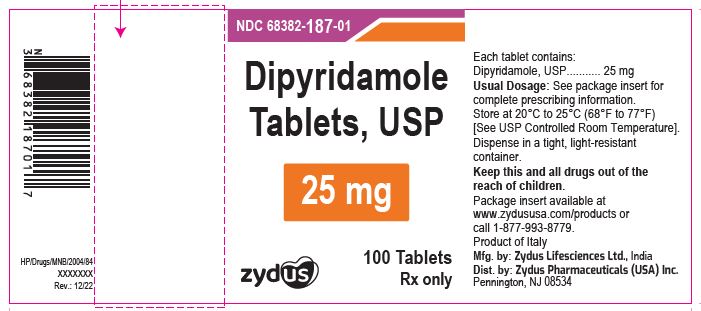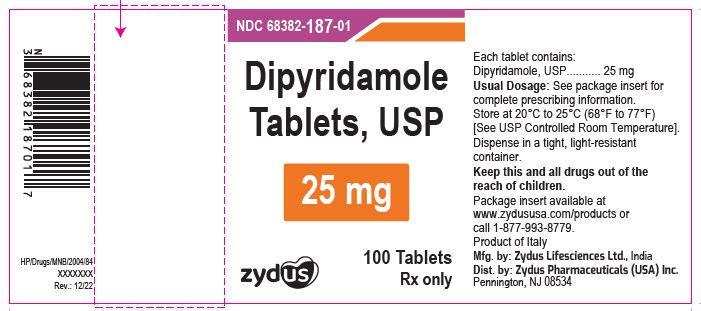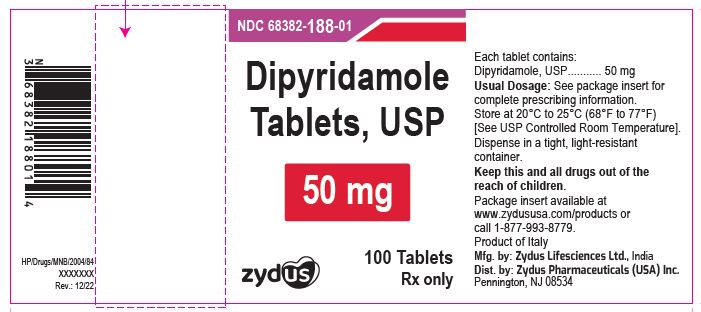Label: DIPYRIDAMOLE tablet, film coated
-
NDC Code(s):
68382-187-01,
68382-187-05,
68382-187-10,
68382-187-77, view more68382-188-01, 68382-188-05, 68382-188-10, 68382-188-77, 68382-189-01, 68382-189-05, 68382-189-10, 68382-189-77
- Packager: Zydus Pharmaceuticals USA Inc.
- Category: HUMAN PRESCRIPTION DRUG LABEL
Drug Label Information
Updated September 16, 2023
If you are a healthcare professional or from the pharmaceutical industry please visit this version.
- Download DRUG LABEL INFO: PDF XML
- Official Label (Printer Friendly)
-
DESCRIPTION
Dipyridamole is a platelet inhibitor chemically described as 2,2',2'',2'''-[(4,8-Dipiperidinopyrimido[5,4-d]pyrimidine-2,6-diyl)dinitrilo]-tetraethanol. It has the following structural formula:

Dipyridamole, USP is intensely yellow crystalline powder or needles. It is very soluble in methanol, in alcohol, and in chloroform; slightly soluble in water; very slightly soluble in acetone and in ethyl acetate.
Each dipyridamole tablet intended for oral administration contains 25 mg or 50 mg or 75 mg of dipyridamole. In addition, each tablet contains the following inactive ingredients: corn starch, hypromellose, iron oxide yellow, lactose monohydrate, magnesium stearate, polyethylene glycol, povidone and titanium dioxide.
-
CLINICAL PHARMACOLOGY
It is believed that platelet reactivity and interaction with prosthetic cardiac valve surfaces, resulting in abnormally shortened platelet survival time, is a significant factor in thromboembolic complications occurring in connection with prosthetic heart valve replacement.
Dipyridamole tablets have been found to lengthen abnormally shortened platelet survival time in a dose-dependent manner.
In three randomized controlled clinical trials involving 854 patients who had undergone surgical placement of a prosthetic heart valve, dipyridamole tablets, in combination with warfarin, decreased the incidence of postoperative thromboembolic events by 62 to 91% compared to warfarin treatment alone. The incidence of thromboembolic events in patients receiving the combination of dipyridamole tablets and warfarin ranged from 1.2 to 1.8%. In three additional studies involving 392 patients taking dipyridamole tablets and coumarin-like anticoagulants, the incidence of thromboembolic events ranged from 2.3 to 6.9%.
In these trials, the coumarin anticoagulant was begun between 24 hours and 4 days postoperatively, and the dipyridamole tablets were begun between 24 hours and 10 days postoperatively. The length of follow-up in these trials varied from 1 to 2 years.
Dipyridamole tablets do not influence prothrombin time or activity measurements when administered with warfarin.
Mechanism of Action
Dipyridamole inhibits the uptake of adenosine into platelets, endothelial cells and erythrocytes in vitro and in vivo; the inhibition occurs in a dose-dependent manner at therapeutic concentrations (0.5 to 1.9 mcg/mL). This inhibition results in an increase in local concentrations of adenosine which acts on the platelet A2-receptor thereby stimulating platelet adenylate cyclase and increasing platelet cyclic-3',5'-adenosine monophosphate (cAMP) levels. Via this mechanism, platelet aggregation is inhibited in response to various stimuli such as platelet activating factor (PAF), collagen and adenosine diphosphate (ADP).
Dipyridamole inhibits phosphodiesterase (PDE) in various tissues. While the inhibition of cAMP-PDE is weak, therapeutic levels of dipyridamole inhibit cyclic-3',5'-guanosine monophosphate-PDE (cGMP-PDE), thereby augmenting the increase in cGMP produced by EDRF (endothelium-derived relaxing factor, now identified as nitric oxide).
Hemodynamics
In dogs intraduodenal doses of dipyridamole of 0.5 to 4.0 mg/kg produced dose-related decreases in systemic and coronary vascular resistance leading to decreases in systemic blood pressure and increases in coronary blood flow. Onset of action was in about 24 minutes and effects persisted for about 3 hours.
Similar effects were observed following intravenous dipyridamole in doses ranging from 0.025 to 2.0 mg/kg.
In man the same qualitative hemodynamic effects have been observed. However, acute intravenous administration of dipyridamole may worsen regional myocardial perfusion distal to partial occlusion of coronary arteries.
Pharmacokinetics and Metabolism
Following an oral dose of dipyridamole tablets, the average time to peak concentration is about 75 minutes. The decline in plasma concentration following a dose of dipyridamole tablets fits a two-compartment model. The alpha half-life (the initial decline following peak concentration) is approximately 40 minutes. The beta half-life (the terminal decline in plasma concentration) is approximately 10 hours. Dipyridamole is highly bound to plasma proteins. It is metabolized in the liver where it is conjugated as a glucuronide and excreted with the bile.
- INDICATIONS AND USAGE
- CONTRAINDICATIONS
-
PRECAUTIONS
General
Coronary Artery Disease
Dipyridamole has a vasodilatory effect and should be used with caution in patients with severe coronary artery disease (e.g., unstable angina or recently sustained myocardial infarction). Chest pain may be aggravated in patients with underlying coronary artery disease who are receiving dipyridamole.
Hepatic Insufficiency
Elevations of hepatic enzymes and hepatic failure have been reported in association with dipyridamole administration.
Hypotension
Dipyridamole should be used with caution in patients with hypotension since it can produce peripheral vasodilation.
Stress Testing with Intravenous Dipyridamole and Other Adenosinergic Agents
Clinical experience suggests that patients being treated with dipyridamole tablets who also require pharmacological stress testing with intravenous dipyridamole or other adenosinergic agents (e.g. adenosine, regadenoson) should interrupt dipyridamole tablets for 48 hours prior to stress testing.
Intake of dipyridamole tablets within 48 hours prior to stress testing with intravenous dipyridamole or other adenosinergic agents may increase the risk for cardiovascular side effects of these agents and may impair the sensitivity of the test.
Drug Interactions
No pharmacokinetic drug-drug interaction studies were conducted with dipyridamole tablets. The following information was obtained from the literature.
Adenosinergic agents (e.g., adenosine, regadenoson)
Dipyridamole has been reported to increase the plasma levels and cardiovascular effects of adenosine. Adjustment of adenosine dosage may be necessary. Dipyridamole also increases the cardiovascular effects of regadenoson, an adenosine A2A-receptor agonist. The potential risk of cardiovascular side effects with intravenous adenosinergic agents may be increased during the testing period when dipyridamole is not held 48 hours prior to stress testing.
Cholinesterase Inhibitors
Dipyridamole may counteract the anticholinesterase effect of cholinesterase inhibitors, thereby potentially aggravating myasthenia gravis.
Carcinogenesis, Mutagenesis, Impairment of Fertility
In studies in which dipyridamole was administered in the feed to mice (up to 111 weeks in males and females) and rats (up to 128 weeks in males and up to 142 weeks in females), there was no evidence of drug-related carcinogenesis. The highest dose administered in these studies (75 mg/kg/day) was, on a mg/m2 basis, about equivalent to the maximum recommended daily human oral dose (MRHD) in mice and about twice the MRHD in rats. Mutagenicity tests of dipyridamole with bacterial and mammalian cell systems were negative. There was no evidence of impaired fertility when dipyridamole was administered to male and female rats at oral doses up to 500 mg/kg/day (about 12 times the MRHD on a mg/m2 basis). A significant reduction in number of corpora lutea with consequent reduction in implantations and live fetuses was, however, observed at 1250 mg/kg (more than 30 times the MRHD on a mg/m2 basis).
Pregnancy
Teratogenic Effects: PREGNANCY CATEGORY B
Reproduction studies have been performed in mice, rabbits and rats at oral dipyridamole doses of up to 125 mg/kg, 40 mg/kg and 1000 mg/kg, respectively (about 11/2, 2 and 25 times the maximum recommended daily human oral dose, respectively, on a mg/m2 basis) and have revealed no evidence of harm to the fetus due to dipyridamole. There are, however, no adequate and well-controlled studies in pregnant women. Because animal reproduction studies are not always predictive of human response, dipyridamole tablets should be used during pregnancy only if clearly needed.
-
ADVERSE REACTIONS
Adverse reactions at therapeutic doses are usually minimal and transient. On long-term use of dipyridamole tablets initial side effects usually disappear. The following reactions in Table 1 were reported in two heart valve replacement trials comparing dipyridamole tablets and warfarin therapy to either warfarin alone or warfarin and placebo:
Table 1 Adverse Reactions Reported in 2 Heart Valve Replacement Trials Adverse Reaction
Dipyridamole Tablets/
Placebo/
Warfarin
Warfarin
Number of patients
147
170
Dizziness
13.6%
8.2%
Abdominal distress
6. 1%
3.5%
Headache
2.3%
0.0%
Rash
2.3%
1.1%
Other reactions from uncontrolled studies include diarrhea, vomiting, flushing and pruritus. In addition, angina pectoris has been reported rarely and there have been rare reports of liver dysfunction. On those uncommon occasions when adverse reactions have been persistent or intolerable, they have ceased on withdrawal of the medication.
When dipyridamole tablets were administered concomitantly with warfarin, bleeding was no greater in frequency or severity than that observed when warfarin was administered alone. In rare cases, increased bleeding during or after surgery has been observed.
In post-marketing reporting experience, there have been rare reports of hypersensitivity reactions (such as rash, urticaria, severe bronchospasm, and angioedema), larynx edema, fatigue, malaise, myalgia, arthritis, nausea, dyspepsia, paresthesia, hepatitis, thrombocytopenia, alopecia, cholelithiasis, hypotension, palpitation, and tachycardia.
-
OVERDOSAGE
In case of real or suspected overdose, seek medical attention or contact a Poison Control Center immediately. Careful medical management is essential. Based upon the known hemodynamic effects of dipyridamole, symptoms such as warm feeling, flushes, sweating, restlessness, feeling of weakness and dizziness may occur. A drop in blood pressure and tachycardia might also be observed.
Symptomatic treatment is recommended, possibly including a vasopressor drug. Gastric lavage should be considered. Administration of xanthine derivatives (e.g., aminophylline) may reverse the hemodynamic effects of dipyridamole overdose. Since dipyridamole is highly protein bound, dialysis is not likely to be of benefit.
- DOSAGE AND ADMINISTRATION
-
HOW SUPPLIED
Dipyridamole Tablets USP, 25 mg are light yellow, round, biconvex, film-coated tablets debossed with 'ZE 43' on one side and plain on the other side are supplied as follows:
NDC 68382-187-01 in bottle of 100 tablets
NDC 68382-187-05 in bottle of 500 tablets
NDC 68382-187-10 in bottle of 1000 tablets
NDC 68382-187-77 in unit-dose blister cartons of 100 (10 x 10) unit-dose tablets
Dipyridamole Tablets USP, 50 mg are light yellow, round, biconvex, beveled-edge, film-coated tablets debossed with 'ZE 49' on one side and plain on the other side are supplied as follows:
NDC 68382-188-01 in bottle of 100 tablets
NDC 68382-188-05 in bottle of 500 tablets
NDC 68382-188-10 in bottle of 1000 tablets
NDC 68382-188-77 in unit-dose blister cartons of 100 (10 x 10) unit-dose tablets
Dipyridamole Tablets USP, 75 mg are light yellow, round, biconvex, beveled-edge, film-coated tablets debossed with 'ZE 50' on one side and plain on the other side are supplied as follows:
NDC 68382-189-01 in bottle of 100 tablets
NDC 68382-189-05 in bottle of 500 tablets
NDC 68382-189-10 in bottle of 1000 tablets
NDC 68382-189-77 in unit-dose blister cartons of 100 (10 x 10) unit-dose tablets
- STORAGE
- SPL UNCLASSIFIED SECTION
- PACKAGE LABEL.PRINCIPAL DISPLAY PANEL
-
INGREDIENTS AND APPEARANCE
DIPYRIDAMOLE
dipyridamole tablet, film coatedProduct Information Product Type HUMAN PRESCRIPTION DRUG Item Code (Source) NDC:68382-187 Route of Administration ORAL Active Ingredient/Active Moiety Ingredient Name Basis of Strength Strength DIPYRIDAMOLE (UNII: 64ALC7F90C) (DIPYRIDAMOLE - UNII:64ALC7F90C) DIPYRIDAMOLE 25 mg Inactive Ingredients Ingredient Name Strength FERRIC OXIDE YELLOW (UNII: EX438O2MRT) HYPROMELLOSE 2910 (6 MPA.S) (UNII: 0WZ8WG20P6) LACTOSE MONOHYDRATE (UNII: EWQ57Q8I5X) MAGNESIUM STEARATE (UNII: 70097M6I30) POLYETHYLENE GLYCOL 3350 (UNII: G2M7P15E5P) POVIDONE K30 (UNII: U725QWY32X) TITANIUM DIOXIDE (UNII: 15FIX9V2JP) STARCH, CORN (UNII: O8232NY3SJ) Product Characteristics Color YELLOW (LIGHT YELLOW) Score no score Shape ROUND (ROUND) Size 6mm Flavor Imprint Code ZE;43 Contains Packaging # Item Code Package Description Marketing Start Date Marketing End Date 1 NDC:68382-187-01 100 in 1 BOTTLE; Type 0: Not a Combination Product 05/22/2008 2 NDC:68382-187-05 500 in 1 BOTTLE; Type 0: Not a Combination Product 05/22/2008 3 NDC:68382-187-10 1000 in 1 BOTTLE; Type 0: Not a Combination Product 05/22/2008 4 NDC:68382-187-77 10 in 1 CARTON 05/22/2008 4 10 in 1 BLISTER PACK; Type 0: Not a Combination Product Marketing Information Marketing Category Application Number or Monograph Citation Marketing Start Date Marketing End Date ANDA ANDA040874 05/22/2008 DIPYRIDAMOLE
dipyridamole tablet, film coatedProduct Information Product Type HUMAN PRESCRIPTION DRUG Item Code (Source) NDC:68382-188 Route of Administration ORAL Active Ingredient/Active Moiety Ingredient Name Basis of Strength Strength DIPYRIDAMOLE (UNII: 64ALC7F90C) (DIPYRIDAMOLE - UNII:64ALC7F90C) DIPYRIDAMOLE 50 mg Inactive Ingredients Ingredient Name Strength FERRIC OXIDE YELLOW (UNII: EX438O2MRT) HYPROMELLOSE 2910 (6 MPA.S) (UNII: 0WZ8WG20P6) LACTOSE MONOHYDRATE (UNII: EWQ57Q8I5X) MAGNESIUM STEARATE (UNII: 70097M6I30) POLYETHYLENE GLYCOL, UNSPECIFIED (UNII: 3WJQ0SDW1A) POVIDONE K30 (UNII: U725QWY32X) TITANIUM DIOXIDE (UNII: 15FIX9V2JP) STARCH, CORN (UNII: O8232NY3SJ) Product Characteristics Color YELLOW (LIGHT YELLOW) Score no score Shape ROUND (ROUND) Size 7mm Flavor Imprint Code ZE;49 Contains Packaging # Item Code Package Description Marketing Start Date Marketing End Date 1 NDC:68382-188-01 100 in 1 BOTTLE; Type 0: Not a Combination Product 05/22/2008 2 NDC:68382-188-05 500 in 1 BOTTLE; Type 0: Not a Combination Product 05/22/2008 3 NDC:68382-188-10 1000 in 1 BOTTLE; Type 0: Not a Combination Product 05/22/2008 4 NDC:68382-188-77 10 in 1 CARTON 05/22/2008 4 10 in 1 BLISTER PACK; Type 0: Not a Combination Product Marketing Information Marketing Category Application Number or Monograph Citation Marketing Start Date Marketing End Date ANDA ANDA040874 05/22/2008 DIPYRIDAMOLE
dipyridamole tablet, film coatedProduct Information Product Type HUMAN PRESCRIPTION DRUG Item Code (Source) NDC:68382-189 Route of Administration ORAL Active Ingredient/Active Moiety Ingredient Name Basis of Strength Strength DIPYRIDAMOLE (UNII: 64ALC7F90C) (DIPYRIDAMOLE - UNII:64ALC7F90C) DIPYRIDAMOLE 75 mg Inactive Ingredients Ingredient Name Strength FERRIC OXIDE YELLOW (UNII: EX438O2MRT) HYPROMELLOSE 2910 (6 MPA.S) (UNII: 0WZ8WG20P6) LACTOSE MONOHYDRATE (UNII: EWQ57Q8I5X) MAGNESIUM STEARATE (UNII: 70097M6I30) POLYETHYLENE GLYCOL, UNSPECIFIED (UNII: 3WJQ0SDW1A) POVIDONE K30 (UNII: U725QWY32X) TITANIUM DIOXIDE (UNII: 15FIX9V2JP) STARCH, CORN (UNII: O8232NY3SJ) Product Characteristics Color YELLOW (LIGHT YELLOW) Score no score Shape ROUND (ROUND) Size 8mm Flavor Imprint Code ZE;50 Contains Packaging # Item Code Package Description Marketing Start Date Marketing End Date 1 NDC:68382-189-01 100 in 1 BOTTLE; Type 0: Not a Combination Product 05/22/2008 2 NDC:68382-189-05 500 in 1 BOTTLE; Type 0: Not a Combination Product 05/22/2008 3 NDC:68382-189-10 1000 in 1 BOTTLE; Type 0: Not a Combination Product 05/22/2008 4 NDC:68382-189-77 10 in 1 CARTON 05/22/2008 4 10 in 1 BLISTER PACK; Type 0: Not a Combination Product Marketing Information Marketing Category Application Number or Monograph Citation Marketing Start Date Marketing End Date ANDA ANDA040874 05/22/2008 Labeler - Zydus Pharmaceuticals USA Inc. (156861945) Registrant - Zydus Pharmaceuticals USA Inc. (156861945) Establishment Name Address ID/FEI Business Operations Zydus Lifesciences Limited 918596198 ANALYSIS(68382-187, 68382-188, 68382-189) , MANUFACTURE(68382-187, 68382-188, 68382-189) Establishment Name Address ID/FEI Business Operations Zydus Lifesciences Limited 677605858 ANALYSIS(68382-187, 68382-188, 68382-189) , MANUFACTURE(68382-187, 68382-188, 68382-189)






